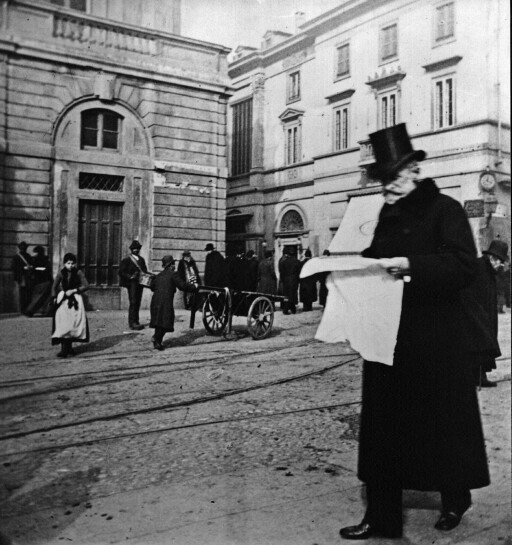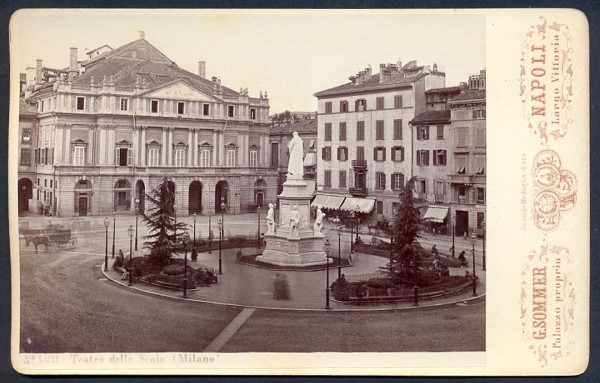- Gustav Mahler did not perform in La Scala.
La Scala is the abbreviation in the Italian language for the official name “Teatro alla Scala”; opera house in Milan, Italy. The theatre was inaugurated on 3 August 1778 and was originally known as the Nuovo Regio Ducale Teatro alla Scala (New Royal-Ducal Theatre alla Scala). The premiere performance was Antonio Salieri’s Europa riconosciuta.
Most of Italy’s greatest operatic artists, and many of the finest singers from around the world, have appeared at La Scala. The theatre is regarded as one of the leading opera and ballet theatres in the world and is home to the La Scala Theatre Chorus, La Scala Theatre Ballet and La Scala Theatre Orchestra. The theatre also has an associate school, known as the La Scala Theatre Academy (Italian: Accademia Teatro alla Scala), which offers professional training in music, dance, stage craft and stage management.
La Scala’s season opens on 7 December, Saint Ambrose’s Day, the feast day of Milan’s patron saint. All performances must end before midnight, and long operas start earlier in the evening when necessary.
The Museo Teatrale alla Scala (La Scala Theatre Museum), accessible from the theatre’s foyer and a part of the house, contains a collection of paintings, drafts, statues, costumes, and other documents regarding La Scala’s and opera history in general. La Scala also hosts the Accademia d’Arti e Mestieri dello Spettacolo (Academy for the Performing Arts). Its goal is to train a new generation of young musicians, technical staff, and dancers (at the Scuola di Ballo del Teatro alla Scala, one of the Academy’s divisions).
A fire destroyed the previous theatre, the Teatro Regio Ducale, on 25 February 1776, after a carnival gala. A group of ninety wealthy Milanese, who owned private boxes in the theatre, wrote to Archduke Ferdinand of Austria-Este asking for a new theatre and a provisional one to be used while completing the new one. The neoclassical architect Giuseppe Piermarini produced an initial design but it was rejected by Count Firmian (the governor of the then Austrian Lombardy).

Giuseppe Fortunino Francesco Verdi (1813-1901) in front of La Scala.
A second plan was accepted in 1776 by Empress Maria Theresa. The new theatre was built on the former location of the church of Santa Maria alla Scala, from which the theatre gets its name. The church was deconsecrated and demolished and, over a period of two years, the theatre was completed by Pietro Marliani, Pietro Nosetti and Antonio and Giuseppe Fe. The theatre had a total of “3,000 or so” seats organized into 678 pit-stalls, arranged in six tiers of boxes above which is the ‘loggione’ or two galleries. Its stage is one of the largest in Italy (16.15m d x 20.4m w x 26m h).
Building expenses were covered by the sale of boxes, which were lavishly decorated by their owners, impressing observers such as Stendhal. La Scala (as it came to be known) soon became the preeminent meeting place for noble and wealthy Milanese people. In the tradition of the times, the main floor had no chairs and spectators watched the shows standing up. The orchestra was in full sight, as the orchestra pit had not yet been built.
Above the boxes, La Scala has a gallery—called the loggione—where the less wealthy can watch the performances. The gallery is typically crowded with the most critical opera aficionados, known as the loggionisti, who can be ecstatic or merciless towards singers’ perceived successes or failures. For their failures, artists receive a “baptism of fire” from these aficionados, and fiascos are long remembered an example being when, in 2006, tenor Roberto Alagna was booed off the stage during a performance of Aida this forced his understudy, Antonello Palombi, to quickly replace him mid-scene without time to change into a costume.
As with most of the theatres at that time, La Scala was also a casino, with gamblers sitting in the foyer. Conditions in the auditorium, too, could be frustrating for the opera lover, as Mary Shelley discovered in September 1840:
At the Opera they were giving Otto Nicolai’s Templario. Unfortunately, as is well known, the theatre of La Scala serves, not only as the universal drawing-room for all the society of Milan, but every sort of trading transaction, from horse-dealing to stock-jobbing, is carried on in the pit; so that brief and far between are the snatches of melody one can catch.
La Scala was originally illuminated with 84 oil lamps mounted on the stage and another thousand in the rest of theatre. To prevent the risks of fire, several rooms were filled with hundreds of water buckets. In time, oil lamps were replaced by gas lamps, these in turn were replaced by electric lights in 1883.
The original structure was renovated in 1907, when it was given its current layout with 1,987 seats. In 1943, during WWII, La Scala was severely damaged by bombing. It was rebuilt and reopened on 11 May 1946, with a memorable concert conducted by Arturo Toscanini—twice La Scala’s principal conductor and an associate of the composers Giuseppe Verdi and Giacomo Puccini—with a soprano solo by Renata Tebaldi, which created a sensation.
Scala conductors
- Franco Faccio (1871-1889)
- Arturo Toscanini (1867-1957) (1898-1908)
- Tullio Serafin (1909-1914, 1917-1918)
- La Scala was closed from 1918 to 1920
- Arturo Toscanini (1867-1957) (1921-1929)
- Victor de Sabata (1930-1953)
- Carlo Maria Giulini (1953-1956)
- Guido Cantelli (1956)
- Gianandrea Gavazzeni (1966-1968)
- Claudio Abbado (1933-2014) (1968-1986)
- Riccardo Muti (1986-2005)
- Daniel Barenboim (1942) (2007-2014)
- Riccardo Chailly (1953) (2015-2022)
Premieres
- 1778: Europa riconosciuta by Antonio Salieri
- 1794: Demofoonte by Marcos Portugal
- 1800: Idante, ovvero I sacrifici d’Ecate by Marcos Portugal
- 1812: La pietra del paragone by Gioachino Rossini (1792-1868)
- 1813: Aureliano in Palmira by Gioachino Rossini (1792-1868)
- 1814: Il turco in Italia by Gioachino Rossini (1792-1868)
- 1820: Margherita d’Anjou by Giacomo Meyerbeer
- 1827: Il pirata by Vincenzo Bellini
- 1829: La straniera by Vincenzo Bellini
- 1831: Norma by Vincenzo Bellini
- 1833: Lucrezia Borgia by Gaetano Donizetti
- 1835: Maria Stuarda by Gaetano Donizetti
- 1839: Oberto, Conte di San Bonifacio by Giuseppe Fortunino Francesco Verdi (1813-1901)
- 1840: Un giorno di regno by Giuseppe Fortunino Francesco Verdi (1813-1901)
- 1842: Nabucco by Giuseppe Fortunino Francesco Verdi (1813-1901)
- 1843: I Lombardi alla prima crociata by Giuseppe Fortunino Francesco Verdi (1813-1901)
- 1845: Giovanna d’Arco by Giuseppe Fortunino Francesco Verdi (1813-1901)
- 1868: Mefistofele by Arrigo Boito
- 1870: Il Guarany by Antônio Carlos Gomes
- 1873: Fosca by Antônio Carlos Gomes
- 1876: La Gioconda by Amilcare Ponchielli
- 1879: Maria Tudor by Antônio Carlos Gomes
- 1885: Marion Delorme by Amilcare Ponchielli
- 1887: Otello by Giuseppe Fortunino Francesco Verdi (1813-1901)
- 1889: Edgar by Giacomo Puccini (1858-1924)
- 1892: La Wally by Alfredo Catalani
- 1893: Falstaff by Giuseppe Fortunino Francesco Verdi (1813-1901)
- 1904: Madama Butterfly by Giacomo Puccini (1858-1924)
- 1924: Nerone by Arrigo Boito
- 1926: Turandot by Giacomo Puccini (1858-1924)
- 1957: Dialogues of the Carmelites by Francis Poulenc
- 1981: Donnerstag aus Licht by Karlheinz Stockhausen
- 1984: Samstag aus Licht by Karlheinz Stockhausen
- 1988: Montag aus Licht by Karlheinz Stockhausen
- 2007: Teneke by Fabio Vacchi
- 2011: Quartett by Luca Francesconi

